- Home
- Articles
- Architectural Portfolio
- Architectral Presentation
- Inspirational Stories
- Architecture News
- Visualization
- BIM Industry
- Facade Design
- Parametric Design
- Career
- Landscape Architecture
- Construction
- Artificial Intelligence
- Sketching
- Design Softwares
- Diagrams
- Writing
- Architectural Tips
- Sustainability
- Courses
- Concept
- Technology
- History & Heritage
- Future of Architecture
- Guides & How-To
- Art & Culture
- Projects
- Interior Design
- Competitions
- Jobs
- Store
- Tools
- More
- Home
- Articles
- Architectural Portfolio
- Architectral Presentation
- Inspirational Stories
- Architecture News
- Visualization
- BIM Industry
- Facade Design
- Parametric Design
- Career
- Landscape Architecture
- Construction
- Artificial Intelligence
- Sketching
- Design Softwares
- Diagrams
- Writing
- Architectural Tips
- Sustainability
- Courses
- Concept
- Technology
- History & Heritage
- Future of Architecture
- Guides & How-To
- Art & Culture
- Projects
- Interior Design
- Competitions
- Jobs
- Store
- Tools
- More
Exploring the Benefits of Parametric Architecture in Sustainable Design

In an era where sustainability is more crucial than ever, parametric architecture is revolutionizing how we design and build our spaces. By leveraging advanced algorithms and computational tools, we can create structures that are not only aesthetically pleasing but also environmentally responsible. This innovative approach allows us to optimize resources, reduce waste, and enhance energy efficiency.
Parametric architecture empowers us to push the boundaries of what’s possible in sustainable design. It enables architects and designers to model complex forms and systems that respond dynamically to environmental conditions. As we explore the benefits of this cutting-edge methodology, we’ll uncover how it can lead to smarter, greener, and more resilient buildings that meet the demands of our changing world.

Table of Contents
ToggleExploring Parametric Architecture
Parametric architecture is reshaping our approach to sustainable design. Using algorithms and computational tools, it offers innovative, environmentally friendly solutions.
What Is Parametric Architecture?
Parametric architecture uses algorithms to define forms by parameters. Instead of traditional blueprints, it uses software to manipulate variables like height, length, and depth. This dynamic approach enables complex, adaptive structures.
Examples:
- Facades adjusting to sunlight
- Roofs collecting and redirecting rainwater
Architects leverage these parameters to tailor designs that respond to environmental and functional needs, creating sustainable and efficient buildings.
The Evolution of Parametric Design
Parametric design dates back to the late 20th century. Advances in computational power in the 1980s and 1990s allowed architects to adopt digital tools and algorithms.
Key Milestones:
- 1993: Introduction of generative design tools
- 2000s: Rise of Building Information Modeling (BIM)
- Present: Integration of AI and machine learning
These advancements have enabled more sophisticated and sustainable architectural solutions. Parametric design now aids in optimizing materials, reducing waste, and enhancing building performance.
- AI-driven predictive modeling
- Real-time data integration for responsive designs
Keeping pace with technology, parametric architecture continuously evolves, offering ever-more sustainable and intelligent building solutions.

Benefits of Parametric Architecture in Sustainable Design
Parametric architecture integrates algorithms and computational tools to drive sustainable design. It enhances energy efficiency and optimizes material usage among other significant advantages.
Enhancing Energy Efficiency
Parametric design enhances energy efficiency by modeling building performance under varied environmental conditions. Algorithms adjust parameters like building orientation, window placement, and shading to maximize natural light while minimizing heat gain. For example, a design tool might position windows to reduce artificial lighting needs by 30%. These adjustments reduce energy consumption and operational costs, which makes buildings more sustainable and cost-effective.
Optimizing Material Usage
Parametric architecture optimizes material usage by precisely calculating structural requirements. Algorithms determine the exact amount of materials like concrete, steel, and glass, minimizing waste. Advanced modeling techniques create structures that use fewer resources without compromising strength or stability. For instance, complex forms might reduce concrete usage by up to 20%, lowering both costs and environmental impact. This efficiency ensures that our designs are both economically and environmentally sustainable.
Case Studies of Parametric Architecture in Sustainable Projects
Parametric architecture plays a crucial role in sustainable design through real-world applications. Let’s explore some prime examples and analyze their sustainability impact.
Example Projects Worldwide
- The Al Bahar Towers, Abu Dhabi:
Al Bahar Towers feature a dynamic façade that responds to sunlight, reducing solar gain by up to 50%. The shading system’s honeycomb design adjusts based on the sun’s position, minimizing the need for artificial cooling. - One Ocean, South Korea:
This pavilion, designed for Yeosu Expo 2012, uses parametric modeling to create free-form roofs that integrate solar panels and rainwater harvesting. The structure maintains a balance between aesthetics and functionality, enhancing its energy efficiency. - The Metropol Parasol, Spain:
Seville’s Metropol Parasol, the world’s largest wooden structure, employs parametric tools to optimize material use. Its innovative design provides natural shade and ventilation, reducing the city’s heat island effect.
- Material Efficiency:
Parametric architecture ensures optimal use of materials, minimizing waste without compromising structural integrity. For example, the Metropol Parasol used wood efficiently, reducing resource consumption. - Energy Consumption:
By adjusting parameters like façade design and building orientation, energy consumption drops significantly. The Al Bahar Towers exemplify this by using a responsive shading system that cuts down cooling energy needs. - Environmental Adaptability:
Parametric designs adapt to local environmental conditions, from rainfall patterns to solar cycles. One Ocean’s roof adapts to collect rainwater and maximize solar energy capture, showcasing adaptability in sustainable design.
These projects highlight the transformative benefits of parametric architecture in sustainable design, offering innovative solutions to contemporary environmental challenges.

Future of Parametric Architecture
The future of parametric architecture looks promising with advanced techniques and sustainable solutions. This approach adapts quickly to environmental changes and harnesses new technologies.
Innovations in Parametric Techniques
Innovations in parametric techniques are enhancing sustainable architecture. 3D printing uses parameters to create structures with minimal waste. Algorithms generate forms optimizing material use and structural integrity. Artificial intelligence (AI) refines these designs by predicting environmental impacts. Virtual reality (VR) allows architects to visualize and adjust designs accurately. Examples include the Emirates Pavilion, which employs parametric design for its energy-efficient structure.
Predictions for Sustainable Design
Parametric architecture’s future in sustainable design shows increasing reliance on environmental variables. We’ll see buildings adapting dynamically to weather conditions, improving energy efficiency. Materials capable of self-repair or changeable properties will become prevalent. Smart cities, integrating parametric elements, will optimize urban planning and resource management. Data from interconnected devices will continuously refine architectural parameters.
Adopting these innovations, we reduce resource consumption and enhance building performance. Sustainable design driven by parametric architecture will play a vital role in addressing climate challenges and shaping the built environment of tomorrow.

Conclusion
Parametric architecture clearly offers significant benefits in sustainable design. By leveraging algorithms and computational tools, we can create structures that minimize environmental impact while maximizing efficiency. This approach allows us to optimize materials and reduce waste, which enhances building performance and sustainability.
Real-world examples, such as the Al Bahar Towers and the Metropol Parasol, exemplify how parametric architecture impacts material efficiency and energy consumption. These case studies demonstrate the practical applications and measurable benefits of incorporating parametric design into architectural projects.
Looking ahead, advancements in 3D printing and AI will push the boundaries of sustainable architecture further. These innovations not only optimize material use but also predict environmental impacts, enabling us to design buildings that adapt dynamically to changing conditions. The future of smart cities, integrating parametric elements, will lead to optimized resource management and resilience against climate challenges.
Implementing parametric architecture in sustainable design is essential for creating eco-friendly and efficient buildings that can adapt to our ever-evolving environmental needs.
Submit your architectural projects
Follow these steps for submission your project. Submission FormLatest Posts
Top 10 Examples of Parametric Architecture Around the World
Parametric architecture is reshaping global design through computational tools that generate fluid...
10 Notable Architects Who Excel in Parametric Design
Discover 10 leading architects who excel in parametric design, showcasing how computation,...
Parametric Design in Bridge Architecture: From Idea to Ribbon-Cut
Parametric design in bridge architecture: how data, rules, and optimization speed iterations,...
8 Principles of Parametric Architecture You Should Know
Parametric architecture merges computational logic with creative exploration, allowing designers to generate...












Leave a comment